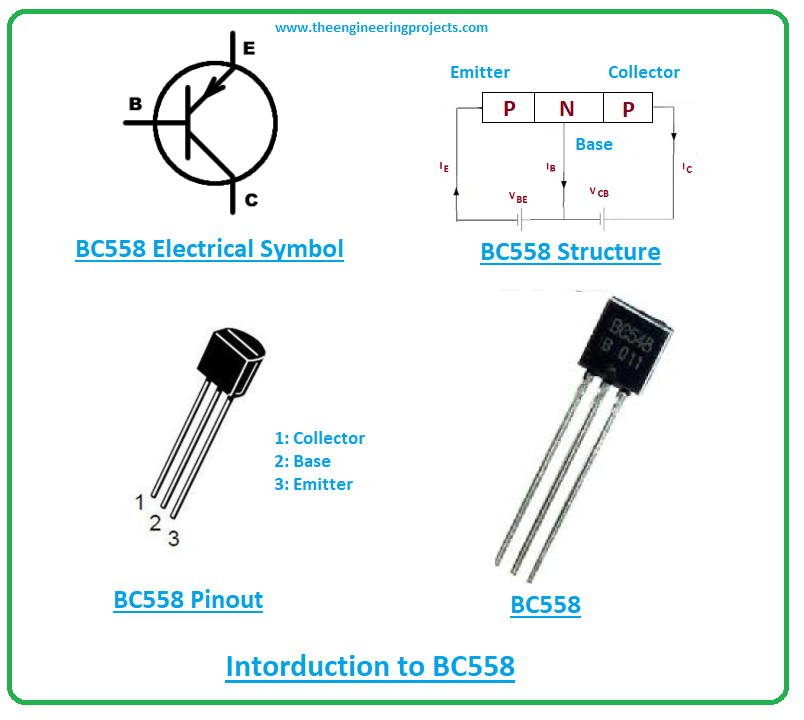
Introduction to BC558
- BC558 is a PNP bipolar junction transistor mainly used for switching and amplification purpose.
- It is made up of three terminals called collector, base, and emitter. All these terminals are different in terms of size, functions, and doping concentrations.
- The small current change at the base side is used to induce large current change across other terminals. This phenomenon is used for amplification purposes.
- BC558 is composed of three layers where one is an n-doped layer and others are p-doped layers. The n-doped layer is sandwiched between two p-doped layers.
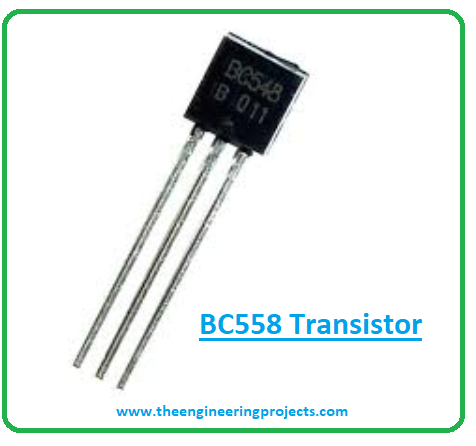
- Both electrons and holes play a crucial rule for the transistor conductivity because here in the case of PNP transistor holes are majority carriers in contrast to NPN transistors where electrons are majority carriers.
- BC558 is also known as a current-controlled device where small current at the base terminal produces a large current change across the remaining terminals.
- This PNP transistor encompasses amplification factors ranging from 110 to 800. This factor actually predicts the amplification capability of the transistor. Simply put, it defines the capacity of the transistor it can amplify the input signal.
- BC558 is composed of silicon material and comes in a TO-92 package.
- The peak collector current is recorded 200mA that makes it a suitable pick for the amplification purpose.
BC558 Datasheet
While working with the electronic component, it’s wise to look at the datasheet that helps you better understand the main characteristic of the component. Click below to download the datasheet of BC558.BC558 Pinout
BC558 contains three pins named:- 1: Collector
- 2: Base
- 3: Emitter
- And in both cases, the base terminal is the component that plays a vital role in the overall transistor action.
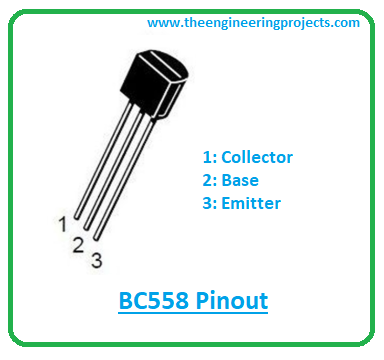
- In this case of PNP transistor, the base terminal controls the number of holes in contrast to the NPN transistor where it controls the number of electrons.
- And base terminal is negative in PNP transistors where it's positive in NPN transistors.
BC558 Working Principle
- When there is no current at the base side, both emitter and collector will be closed and the transistor is turned ON, indicating the forward-biased mode of the transistor.
- And when there is current at the base terminal both emitter and collector will remain opened indicating reverse biased mode of the transistor.
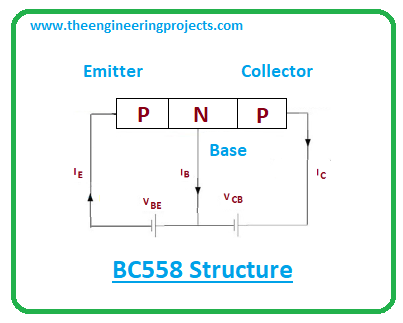
- The base terminal controls the conductivity of the transistor while the emitter terminal carries the whole current of the transistor.
- The emitter terminal is highly doped as compared to the other two terminals. The base is negative while both emitter and collector are positive.
BC558 Power Ratings
The following table represents the absolute maximum ratings of the BC558 transistors.| Absolute Maximum Ratings BC558 | ||||
|---|---|---|---|---|
| No. | Rating | Symbol | Value | Unit |
| 1 | Collector-Emitter Voltage | Vce | 80 | V |
| 2 | Collector-Base Voltage | Vcb | 80 | V |
| 3 | Emitter-Base Voltage | Veb | 5 | V |
| 4 | Collector Current | Ic | 100 | mA |
| 5 | Collector Peak Current | Icm | 200 | mA |
| 6 | Power Dissipation | Ptot | 500 | mW |
| 7 | Storage Temperature | Tstg | 150 | C |
- These are the stress ratings. Before you install this component in your project, make sure these ratings don’t exceed the recommended ratings, else they can severely affect the overall working of the component and in the worst cases, can damage the entire project.
- Plus, if these ratings are applied for an extended time, the device reliability can be severely damaged.
Difference between PNP and NPN transistors
- Both transistors almost operate similarly with few exceptions. The voltage polarities and current directions will be reversed.
- In NPN transistor current flows from collector to emitter and from emitter to collector in case of PNP transistor. And holes are the majority charge carriers in PNP transistors and electrons are major charge carriers in the NPN transistors.
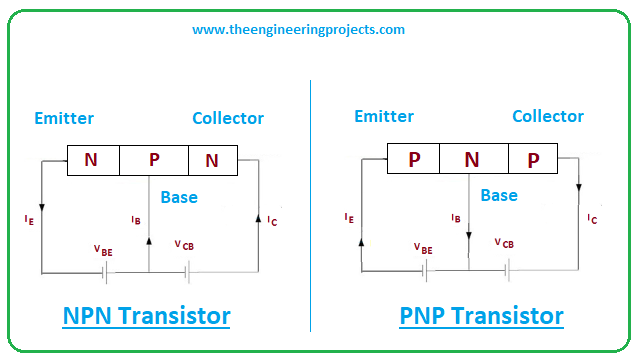
- And in both cases, the base terminal is responsible for the transistor conductivity i.e. it controls the number of electrons in case of NPN transistor and the number of holes in the case of PNP transistors.
- It is important to mention NPN are preferred over PNP transistors for amplification purpose because the mobility of electrons is far better and quicker than the movement of holes in PNP transistors.
- In some cases, however, both are incorporated into a single project to attain amplification.
BC558 Alternatives
The following are a few alternatives to the BC558 transistor.- TIP127
- BC157
- 2N3906
- BC556
- BD140
- 2SA1943
- S8550
- TIP42
BC558 Applications
The following are some applications of BC558:- Used for amplification and switching purposes.
- Used to control motor.
- Employed for impedance buffering.
- Employed to drive loads under 100mA.
- Incorporated in robotics and instrumentation projects.
- Used in H- Bridge circuits and current mirror circuits.
- Used for constructing Astable bistable and Bistable multivibrators.
- Used in comparator and oscillator circuits.
BC558 Physical dimensions
The following figure shows the physical dimensions of the BC558 transistor.



